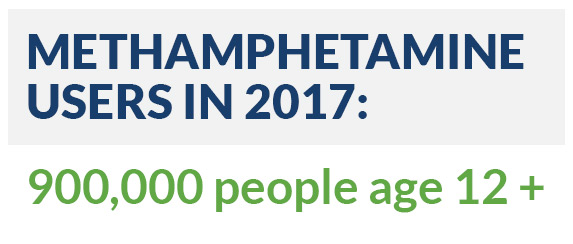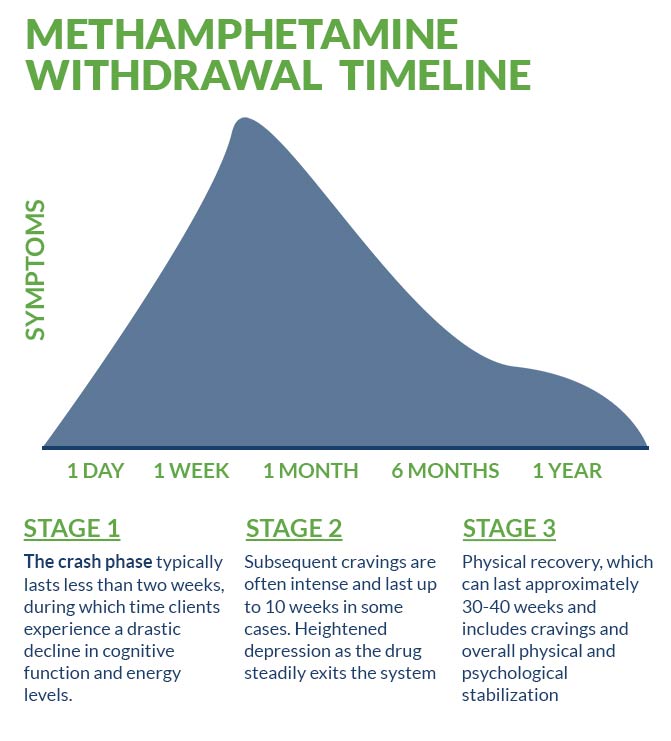Read the latest and greatest from our team
of incredible specialists.

Beach House Recovery Center » Blog » Methamphetamine Detox – Withdrawal Symptoms and Timeline
Methamphetamine (“meth” for short) is classified as a highly addictive stimulant by the Drug Enforcement Administration (DEA). Also known on the black market as “ice,” “crystal,” “chalk,” “blade,” “quartz,” “glass,” and by a host of other street-savvy code names, methamphetamine is available in a variety of forms— most commonly fine, crystallized powder.
Originally developed by Japanese scientist Nagayoshi Nagai in 1893, methamphetamine was first used during World War 11 by American, German, English and Japanese soldiers for preventing fatigue and increasing endurance on the battlefield. In subsequent decades, its popularity quickly burgeoned, reaching epidemic proportions by the time Congress passed the Comprehensive Methamphetamine Control Act in 1996. This legislation imposed strict regulations on mail order companies and chemical plants selling chemicals used to mass produce meth. Now manufactured in underground “meth labs,” the dangerously potent drug is responsible for spawning a culture of crime, disease, overdose and death.

 Although methamphetamine is legitimately prescribed to treat attention deficit hyperactivity disorder (ADHD) and as part of short-term weight loss regimens, the adverse effects associated with the drug far outweigh its benefits. According to the US Department of Justice (DOJ), in 2017, approximately 900,000 people age 12 and older currently used methamphetamine, many of them illicitly. Additionally, 85-90 percent of stimulant-related drug deaths involved meth: a whopping 225 percent spike in stimulant death rates over the past decade. In 2015, a record 225,000 people began using meth. Increasing evidence implicates the drug in a lengthy list of health problems and diseases. In light of these statistics, chronic methamphetamine users place themselves at incredible risk, with the majority requiring professional medical detox in order to recover from its debilitating effects.
Although methamphetamine is legitimately prescribed to treat attention deficit hyperactivity disorder (ADHD) and as part of short-term weight loss regimens, the adverse effects associated with the drug far outweigh its benefits. According to the US Department of Justice (DOJ), in 2017, approximately 900,000 people age 12 and older currently used methamphetamine, many of them illicitly. Additionally, 85-90 percent of stimulant-related drug deaths involved meth: a whopping 225 percent spike in stimulant death rates over the past decade. In 2015, a record 225,000 people began using meth. Increasing evidence implicates the drug in a lengthy list of health problems and diseases. In light of these statistics, chronic methamphetamine users place themselves at incredible risk, with the majority requiring professional medical detox in order to recover from its debilitating effects.
Methamphetamine is extraordinarily damaging to the human body. As a stimulant, it assaults the cardiovascular system, disrupts normal rhythms and causes abnormal clots— resulting in elevated blood pressure and an increased likelihood of heart attack. Aside from the deadlier, long-term potency of the drug, short-term effects may include severe malnutrition, weight loss, insomnia, damaged nasal passages, tooth decay, open sores and infections, and damage to the kidneys, liver and lungs.
Prior to beginning detox, clients are given a comprehensive medical and psychiatric evaluation that helps determine specifics, including when medication-assisted treatment (MAT) will begin and optimal behavioral therapies. Depending upon the age and overall health of the client, and whether or not they are experiencing early or late stage symptoms, methamphetamine withdrawal may include the following cluster of symptoms:

Methamphetamine withdrawal is characterized by three formal stages:
Unlike the accelerated withdrawal process associated with certain opiates and other recreational drugs, methamphetamine withdrawal is renowned for being slow and difficult.
Undoubtedly, the most intense symptoms peak within the first 24 hours following dosage. Although the intensity gradually wears over the course of a week, it is considered the most critical period for clients, with medical supervision and management necessary in order to achieve optimal outcomes. After successfully transitioning through all three stages, clients face an extended withdrawal process known as post-acute withdrawal syndrome (PAWS) that can last for months and, in some cases, years following discontinuation of use.
Methamphetamine is a fast-acting stimulant that is metabolized fairly quickly. Depending upon kidney, liver and heart function (and individual biochemistry), the effects of methamphetamine last for approximately 8-24 hours in the majority of clients. The half-life of methamphetamine lasts between 12-34 hours, which means that it takes between 12-34 hours for the quantity of meth present in the blood to decrease by half.
Urine testing, the preferred method of ongoing screening used by drug rehabs, can typically detect meth for up to 72 hours. Blood and saliva testing yield similar results, with detectable traces registering for approximately three days. Other methods of detection like hair analysis provide the longest range of detection, with traces registering for up to 90 days.
Inpatient treatment offers an intensive, short-term protocol where clients live at a designated treatment facility while completing a medically supervised, clinically-focused program. Inpatient treatment is widely considered the industry-preferred method of methamphetamine detox, since clients receive the evidence-based benefit of ongoing care from licensed medical professionals and clinicians. Above and beyond the premium level of care that includes 24/7 staff monitoring, reputable facilities often include valuable amenities such as aftercare planning, alumni networking, holistic education and supervised recreational activities.
Medication-assisted treatment (MAT) is the staple of methamphetamine detox and consists of Food and Drug Administration (FDA)-approved pharmacological interventions in combination with evidence-based therapies. In addition to regular medication management, clients are assigned one-on-one and group therapy as part of their ongoing treatment regimen. Dialectical behavioral therapy (DBT), motivational interviewing (MI), trauma-informed therapy, family therapy, and cognitive behavioral therapy (CBT) are all commonly utilized depending upon duration of treatment and specific client needs. Primary medications geared toward minimizing the adverse effects associated with stimulant use include:
A variety of anxiety and depression-related disorders are statistically associated with methamphetamine addiction. If present, these “co-occurring” disorders require medical treatment in order for optimal outcomes to be achieved. Post-traumatic stress disorder (PTSD), in particular, has been increasingly implicated in meth addiction. Precipitating factors associated with PTSD including unresolved emotional conflicts and dissociation lead clients to self-medicate, unintentionally producing isolation and a negative, self-perpetuating feedback loop.
Outpatient treatment is another popular treatment method for those requiring greater flexibility. Since clients are not required to live at a designated facility for the duration of treatment, outpatient treatment is a cheaper, but generally less effective alternative, ideally suited for client’s whose personal and professional schedules demand it. Also appropriate for use as a transitional level of care by those successfully completing inpatient detox, outpatient treatment may be an excellent choice for those struggling with social and environmental triggers or experiencing first-time relapse in early recovery.
Self-guided, at-home methamphetamine detox is never recommended under any circumstance. Even in cases of mild recreational use or short-term experimentation, self-detox invariably leads to suboptimal treatment outcomes and increases the likelihood of future relapse.
Tapering is a highly controversial practice that involves a doctor administering diminishing doses of methamphetamine to a client undergoing detox. In addition to subjecting the body to the same addictive substance that led to a downward spiral, tapering is associated with unfavorable treatment outcomes. By the same token, abruptly discontinuing methamphetamine use—a phenomenon known as “quitting cold turkey”—is equally risky. Therefore, the safest, most reliable treatment method is based upon appropriate pharmacological interventions as described previously in the MAT section.
Affordability, insurance coverage, facility reputation, location, duration, and level of treatment required are all key aspects involved in making an informed decision. Fortunately, this process can be relatively stress-free thanks to the help of experienced admissions staff who are able to verify coverage and benefits prior to beginning treatment. Even in cases where partial or total coverage is denied, additional options may be available to help make treatment affordable.
Success in early recovery, especially long-term success, depends upon a variety of factors such as individual client motivation and family support. Beyond these critical ingredients, an empirically-proven, industry-trusted relapse prevention plan should include the following components:
Remember, overdose is considered a life-threatening medical emergency to be treated at a hospital emergency room (ER).
For more about methamphetamine addiction and recovery, check out these related articles:
Journal of Substance Abuse Treatment. A Review of Methamphetamine Dependence and Withdrawal Treatment: A Focus on Anxiety Outcomes. Dec, 2016.
The Medical Journal of Australia. “Ice” (crystal methamphetamine): concerns and responses. March, 2016.
Science Direct Pharmacological Research. Methamphetamine: Effects on the brain, gut and immune system. June, 2017.
Mayo Clinic Proceedings. Methamphetamine Abuse: A Perfect Storm of Complications. Jan, 2006.
Whether you’re researching for yourself or a loved one, Beach House can help. We understand that this is a serious time in your life and that the treatment center you choose matters. We want you to feel comfortable and empowered to make the right decision for yourself, a friend, or a family member. This is why a counselor is waiting and available to answer your questions and help put your mind at ease regarding the next steps. Many of the staff at Beach House have walked in your shoes. If you feel you’re ready or want more information about how to help a loved one, we can help today. You can also learn why we are voted the #1 rehab for addiction treatment in Florida.
We accept most major insurance plans and can verify your benefits quickly and confidentially.
We’re committed to helping you access the care you need, our admissions counselors can guide you through your coverage options and available resources.





"*" indicates required fields